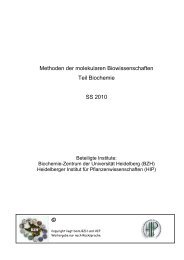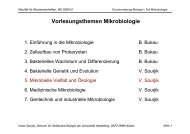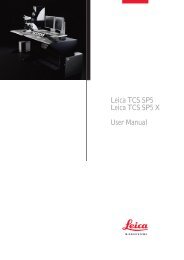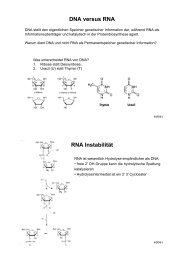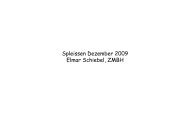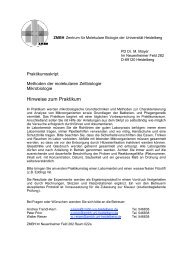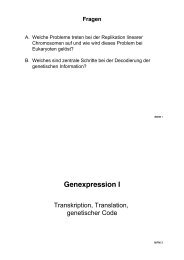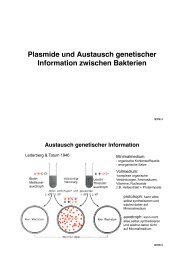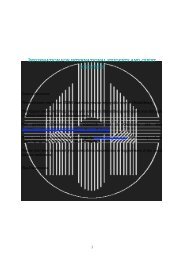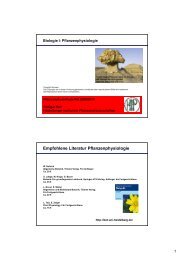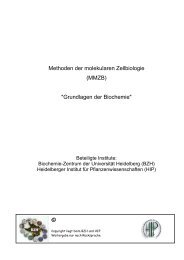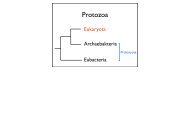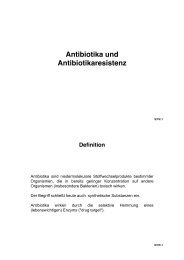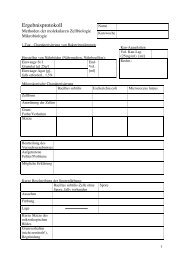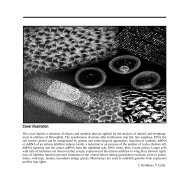ZMBH J.Bericht 2000 - Zentrum für Molekulare Biologie der ...
ZMBH J.Bericht 2000 - Zentrum für Molekulare Biologie der ...
ZMBH J.Bericht 2000 - Zentrum für Molekulare Biologie der ...
You also want an ePaper? Increase the reach of your titles
YUMPU automatically turns print PDFs into web optimized ePapers that Google loves.
the HBV genome is expressed only in a particular<br />
subset of hepatocytes, again demonstrating the importance<br />
of liver architecture and of hepatocyte microenvironment.<br />
Analysis of virus replication in HBVtransgenic<br />
mice lacking the large envelope protein do<br />
not support a prominent role of the L protein for regulating<br />
the levels of intracellular replication intermediates<br />
in HBV, in contrast to evidence for such a mechanism<br />
for the DHBV system.<br />
II. Hepadnavirus replication after transfer of<br />
hepadnaviral genomes mediated by adenoviral<br />
vectors<br />
M. Sprinzl, H. Oberwinkler, B. Zachmann-Brand,<br />
J. Dumortier, U. Protzer<br />
To bypass the species barrier that precludes animal<br />
studies with the human HBV, we have established<br />
recombinant adenoviruses that transfer HBV and<br />
DHBV genomes into heterologous hepatocytes, or<br />
into cell lines which are not infectable but capable<br />
of supporting virus replication. In contrast to transfection,<br />
this approach allows to introduce a defined<br />
number of hepadnavirus genomes, thereby simulating<br />
natural initiation of hepadnavirus replication from<br />
extrachromosomal DNA templates; it should enable<br />
us to study in more detail in vitro and in vivo the influence<br />
of the state of the host hepatocyte, and the use of<br />
immune mediators on hepadnavirus replication. Thus,<br />
we have started to use adenoviral genome transfer into<br />
cultured mouse hepatocytes to test for the influence of<br />
defined immune mediators (from the mouse) on hepatitis<br />
B virus replication in vitro. Furthermore, transduction<br />
of hepadnavirus genomes was shown to efficiently<br />
establish HBV and DHBV replication in the<br />
mouse liver, yielding serum titers comparable to those<br />
from HBV-transgenic animals. In these mice, viral<br />
118<br />
gene expression and replication was maintained for<br />
up to three months, provided that an (adenovirusdirected)<br />
immune response was suppressed.<br />
III. A Golgi-resident protein participates as<br />
an uptake receptor in duck hepatitis B<br />
virus infection<br />
K. Breiner, B. Glass, S. Urban<br />
Major efforts through two decades have produced a<br />
growing list of HBV receptor candidates, mostly only<br />
defined as virus binding proteins, but have failed to<br />
characterize any of these functionally. More progress<br />
has been made in the DHBV animal model which<br />
allows infection experiments with primary hepatocytes.<br />
Including this essential complement for analysis,<br />
we have now identified and characterized in detail<br />
a bona fide DHBV receptor molecule, which plays<br />
a crucial role in a conceptually new mechanism of<br />
viral entry. This protein, a cellular carboxypeptidase<br />
(CPD, historically termed gp180), had been initially<br />
only characterized as a virus binding protein - and met<br />
with scepticism since it lacked the expected tissue tropism,<br />
species specificity, and since is predominantly<br />
concentrated in the trans-Golgi network and not at the<br />
plasma membrane where conceptually viruses must<br />
interact with host cell receptor(s). Our conclusion that<br />
gp180 is nevertheless a functional DHBV receptor<br />
is based on a comprehensive series of experimental<br />
observations: (i) gp180 is the only duck protein that<br />
binds to recombinant DHBV preS, a ligand on the<br />
virus surface previously shown to be essential for<br />
infection, (ii) a preS subdomain, functionally defined<br />
in infection competition experiments, coincides with<br />
the domain determining physical gp180 binding, (iii)<br />
anti-gp180 antibodies, as well as recombinant gp180/<br />
CPD, efficiently block DHBV infection of cultured<br />
duck hepatocytes, (iv) expression of gp180 in a<br />
human hepatoma cell line mediates cellular attachment<br />
and subsequent internalization of fluorescently<br />
labeled DHBV particles into vesicular structures;<br />
gp180 expression does, however, not ren<strong>der</strong> these<br />
heterologous cells permissive for productive DHBV<br />
infection. Furthermore, gp180/CPD is down-regulated<br />
in DHBV-infected cells through intracellular interaction<br />
with the preS ligand, a finding matching our<br />
observation that DHBV infection reduces subsequent<br />
superinfection about 20-fold. Taken together, these<br />
and further data support the model that gp180/CPD<br />
acts as the uptake receptor in a multistep process<br />
(Fig.3). Although predominantly concentrated intracellularly,<br />
the very limited cell surface exposition of<br />
gp180/CPD (varied experimentally by gp180-transducing<br />
adenoviruses) was found to be sufficient to<br />
mediate virus particle uptake by coendocytosis, while<br />
fusion at an endosomal membrane is predicted to<br />
require an (yet unknown) species-specific fusion coreceptor.<br />
Thus, gp180/CPD represents a first example<br />
for a receptor that is virtually absent from the cell surface,<br />
but nevertheless recognized and utilized for virus<br />
Figure 3. Model of cellular gp180 traffic and DHBV entry.<br />
DHBV-complexed gp180 is arrested in the endosome to<br />
allow interaction with a second receptor postulated to trigger<br />
membrane fusion (Breiner et al., <strong>2000</strong>).<br />
internalization leading to productive infection. These<br />
new insights into hepadnaviral entry from the DHBV<br />
model are now being used to re-design the strategies<br />
in our search for the receptor of the medically relevant<br />
human HBV.<br />
IV. Signals for bidirectional cyto-nucleoplasmic<br />
transport in the DHBV capsid protein<br />
H. Mabit, K. Breiner, A. Knaust, B. Zachmann-<br />
Brand<br />
Like other viruses that replicate in the nucleus, the<br />
hepadnaviruses rely on the the cellular cyto-nucleoplasmic<br />
transport machinery to bring the infecting<br />
nucleocapsid to the nucleus. To get insight into the<br />
mechanism operating and the signals used, we have<br />
started to study this process in the DHBV system. By<br />
analyzing the subcellular localization of various segments<br />
of the DHBV core protein (DHBc) fused to<br />
the green fluorescent protein, and by further mutational<br />
analysis, we mapped a single nuclear localization<br />
signal (NLS) in the DHBc sequence. Mutational<br />
inactivation of this sequence prevented DHBc nuclear<br />
targeting (Fig. 4), and in the context of the complete<br />
virus genome, it blocked virus production from<br />
transfected cells. The mutant genome was still capable<br />
of directing the early steps of DHBV infection in<br />
duck hepatocytes, however, compared to wild type,<br />
with delayed gene expression and without infecting<br />
neighbouring cells, both results supporting the interpretation<br />
that the NLS is essential for intracellular<br />
genome amplification and virus production.<br />
Finally, evidence from heterokaryon experiments suggests<br />
that the DHBc sequence contains, in addition to<br />
its NLS, also a nuclear export signal. We propose<br />
that this NES, or a bidirectional shutling signal, counterbalances<br />
NLS function in the productive state of<br />
119



